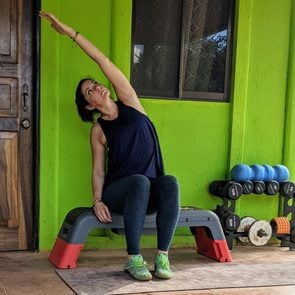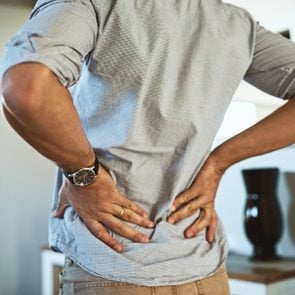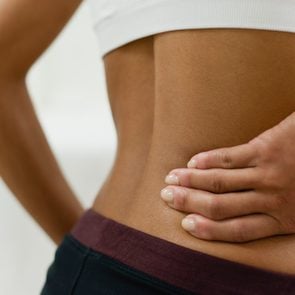3 Mid-Back Stretches to Help Ease Back Pain
Updated: Jul. 02, 2021
If you're experiencing aches in your mid-back, try these stretches for mid-back pain relief. They can loosen you up and help you feel better.
The prevalence of back pain
Back pain is the leading cause of disability worldwide, with an estimated 80 percent of the population experiencing aches at some point in their lives, according to the American Chiropractic Association.
But just because back pain is common doesn’t mean you have to suffer with the masses. A few strategies—including some stretches to improve your range of motion—may help you sidestep the pain (depending on the underlying cause, of course).
Here’s what to know about the causes of mid-back pain, how to avoid it, and the best stretches to help alleviate the aches.
What causes mid-back pain?
An important fact to keep in mind: heart attacks can sometimes present as mid-back pain, so it’s always smart to get your back pain checked out by a doctor, says Houman Danesh, MD, director of integrative pain management at Mount Sinai hospital in New York City.
Another reason to see a doc is if your pain is limiting your daily activity or you have pain you can’t explain. A health care provider can make sure your back pain isn’t arthritis or another medical issue.
If you’re dealing with run-of-the-mill back pain, there may be a few reasons for that. And top of the list: all that sitting you do.
Lack of movement
“The most common problem for people with mid-back issues is sitting all day, which means we lose range of motion in the thoracic [mid] spine, both from front to back and side to side,” says Dr. Danesh.
Static positions, in general, can be problematic for the back—no matter how you sit or stand.
“It’s not that we have one posture that’s better than another,” says Jen Hosler, a physical therapist, strength coach, and owner of Movement Upgraded in Tampa, Florida. “We just need to constantly move because staying in one position means the forces from gravity create tension in one area while changing positions makes sure the forces are distributed from one tissue to another.”
Injuries and limited range of motion
Because our body is a kinetic chain (meaning everything is connected), having a limited range of motion in one area of the body can lead to less mobility in another area.
For example, lack of mobility in the shoulder or an injury to the rotator cuff (the muscles that stabilize the shoulder) could lead to mid-back pain.
Similarly, irritated or inflamed joints in the neck may also lead to mid-back pain, Dr. Danesh says.
Muscle imbalance
Muscle imbalances—say, tight chest muscles and weak back muscles—can lead to mid-back pain, which also leads to poor posture, Dr. Danesh explains.
So while sitting with the correct posture will temporarily ease back pain, getting to the root of the posture problem (and therefore the aches) is the best way to go. That means doing both strengthening and stretching exercises to address both tight areas and weak muscles.
How you breathe
Finally, how we breathe can affect the mobility of the back, Hosler says.
The position we take in front of computer and phone screens inhibits upper shoulder and chest movement as we breathe. It keeps the rib cage from expanding and the breath from reaching the back, which can contribute to tightness.
How can I avoid mid-back pain?
For starters, get up from your seat and your desk at least every hour, says Hosler.
“We don’t pay attention to our bodies until they’re achey and painful, but the best thing to do is break up staying in one posture by using a timer,” she says.
When the timer dings each hour, do one or two exercises (even breathing strategies help) to get your blood flowing.
We know what you’re thinking: “I have no time for that!” But don’t use a busy workday as an excuse; find a workaround. You could pair movement with going to the bathroom or getting a drink of water throughout the day.
Strengthening the rotator cuff muscles will also help ease aches of the mid-back. Dr. Danesh suggests lifting your arms into Y and W shapes (with or without weights) to strengthen your shoulders.
He also suggests looking at your foundation—not just your back.
Your glutes (the muscles of your butt) might be weak, preventing your low back from maintaining stability. So your mid-back, which should be more mobile than stable, has to take over. This can lead to back pain.
“You can’t increase flexibility in the mid-back if you don’t have stability in the low back,” Dr. Danesh says. “Think about the Leaning Tower of Pisa. If you only focus on the top, you won’t address the issue.”
To contribute to movement at the spine, which will help address aches in the mid-back, you can also do a few simple dynamic stretches.
Stretches for mid-back pain
Stretches can help with back pain, and they’ll feel good in the moment, but to determine which moves to do, you’ll need a physical assessment, says Hosler.
The moves below are a good starting point, working to “create an environment that will actually address the issue” of mid-back pain, Hosler says. They’ll get blood flowing to the mid-back and will help you to add mobility where you need it most.
Thoratic spine CARs
CARs stands for controlled articular rotations, which is basically like “brushing and flossing for the joints,” says Hosler.
Start sitting in a chair. For an easier variation, you can stand with feet wide, knees slightly bent, and body stable.
Wrap your arms around your torso like you’re giving yourself a hug.
Tuck your chin to your chest, then flex the body down, rounding the spine forward as if you were trying to get yourself into a ball.
Stay as tight as possible as you make a big circle with your upper body, rotating to the left side. Continue the movement backward so your chest is reaching the ceiling and your back is bending. Then come back down the right side.
Think of the move as your sternum drawing a big circle.
Do five reps. Repeat, moving in the other direction.
Spine segmentation CARs
Think of this as a slower, more segmented version of the cat-cow stretch, Hosler says.
Start on all fours, with your shoulders over your wrists and your knees under your hips.
Start from the tailbone, moving one vertebra at a time to round the spine. Arch the spine from low back to mid-back to upper back. End with the head and neck tucked.
One vertebra at a time, reverse the process to arch the spine. Drop the tailbone, arch the mid-back and then upper back. Finally, raise the head.
Repeat each move for five reps.
Then reverse the movement, starting with the head and neck and ending with the low back and tailbone. Do five reps each of rounding and arching.
(Try these stretches for upper back pain.)
Deep Breathing
For many people, the thoracic (or upper) spine doesn’t move well, which makes it hard for the upper back to expand when you breathe. This exercise will help you breathe better.
“Most people benefit from learning how to breathe into the side rib cage, as well as the low and mid-back,” Hosler says.
Place your hands on the sides of your body, at your ribs. Take three to five deep breaths. With each inhale and exhale, you should feel your body expanding beneath your hands.
Next, place your hands on your low back, with your thumbs resting just outside your spine. Take three to five deep breaths, aiming for your breath to reach your fingers with every inhale and exhale.
Next, check out this guide to back pain symptoms, treatments, and prevention.



